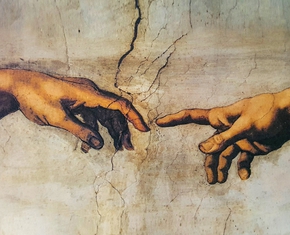The views expressed in our content reflect individual perspectives and do not represent the authoritative views of the Baha'i Faith.
The world beyond is a world within. This may sound odd, but it appears to be a spiritual reality of which we are only dimly aware.
The Baha’i writings, in several places, state that our dreams positively prove the existence of another world, or another dimension, outside of space and time. It’s a place that’s not a place. In other words, it’s a reality, all too often denied, yet very real, and maybe closer than you think. Let me explain by first quoting a passage from Baha’u’llah, the prophet and founder of the Baha’i Faith:
In like manner, this world [the “dream state”] denoteth the place of gathering and resurrection after death, for as Luqmān [Aesop] hath said to his son: “If thou art able to sleep, thou art able to die; and if thou art able to waken after sleep, thou art able to rise after death.” Just as death is a reality, so is the world of the dream; and just as there is waking after sleep, there is rising after death. – Tablet of Wisdom
Here, “this world” refers to the true dream state (as distinct from mere imagination such as daydreaming) which Baha’u’llah described as the place of “resurrection after death.” So, rather than the heavenly realms of the afterlife being located far and away in some distant galaxy, the “reality” of “rising after death” or “resurrection after death” is somehow connected to the world of dreams.

Let’s develop this idea further. Elsewhere Baha’u’llah wrote:
Indeed, O brother, if we ponder each created thing, we shall witness a myriad consummate wisdoms and learn a myriad new and wondrous truths. One of the created phenomena is the dream. Behold how many secrets have been deposited therein, how many wisdoms treasured up, how many worlds concealed. Observe how thou art asleep in a dwelling, and its doors are shut; on a sudden thou findest thyself in a far-off city, which thou enterest without moving thy feet or wearying thy body. Without taxing thine eyes, thou seest; without troubling thine ears, thou hearest; without a tongue, thou speakest. And perchance when ten years have passed, thou wilt witness in this temporal world the very things thou hast dreamt tonight.
Now there are many wisdoms to ponder in the dream, which none but the people of this valley can comprehend in their reality. First, what is this world where without eye or ear or hand or tongue one can put all these to use? Second, how is it that in the outer world thou seest today the effect of a dream which thou didst witness in the world of sleep some ten years past? Consider the difference between these two worlds, and the mysteries they conceal, that, attended by divine confirmations, thou mayest attain unto heavenly discoveries and enter the realms of holiness.
God, the Most High, hath placed these signs in men so that veiled minds might not deny the mysteries of the life beyond, nor belittle that which hath been promised them.
Baha’u’llah spoke here about the “outer world” and the inner “world of sleep.” The “world of sleep” is actually a world of consciousness that operates independently of our awakening consciousness. The waking state operates by use of the physical senses, while the true dream state does not. Yet dreams offer us a world of experience, with their own sights and sounds proceeding independently of the five physical senses. So are there any other senses by which we experience in the true dream state? Is it just our vivid imaginations? Or is there another explanation? One such explanation is the theory of the “inner senses” or psychic faculties that operate independently of the physical senses, as explained by Abdu’l-Baha:
There are five outward material powers in man which are the means of perception—that is, five powers whereby man perceives material things. They are sight, which perceives sensible forms; hearing, which perceives audible sounds; smell, which perceives odours; taste, which perceives edible things; and touch, which is distributed throughout the body and which perceives tactile realities. These five powers perceive external objects.
Man has likewise a number of spiritual powers: the power of imagination, which forms a mental image of things; thought, which reflects upon the realities of things; comprehension, which understands these realities; and memory, which retains whatever man has imagined, thought, and understood. The intermediary between these five outward powers and the inward powers is a common faculty, a sense which mediates between them and which conveys to the inward powers whatever the outward powers have perceived. It is termed the common faculty as it is shared in common between the outward and inward powers.
For instance, sight, which is one of the outward powers, sees and perceives this flower and conveys this perception to the inward power of the common faculty; the common faculty transmits it to the power of imagination, which in turn conceives and forms this image and transmits it to the power of thought; the power of thought reflects upon it and, having apprehended its reality, conveys it to the power of comprehension; the comprehension, once it has understood it, delivers the image of the sensible object to the memory, and the memory preserves it in its repository.
The outward powers are five: the power of sight, of hearing, of taste, of smell, and of touch. The inward powers are also five: the common faculty and the powers of imagination, thought, comprehension, and memory.
So the mechanisms by which we experience dreams, without the intermediary of the senses, occurs by way of defined inner senses or inward powers: (1) the common faculty; (2) the imagination; (3) thought; (4) comprehension; and (5) memory.
- Common Faculty: Here, it would appear that the common faculty is an input mechanism.
- Imagination: The imagination is the ability to perceive what is important by way of abstraction. In other words, the imagination abstractly “sees” (that is, perceives) that which has been transmitted by the common faculty.
- Thought: The power of thought is the process of interpreting and making sense of what the mind perceives.
- Comprehension: After this phase of “thought processing,” comprehension occurs – in other words, an understanding is attained, as a result of data from the common faculty processed by abstract thought until that data is understood.
- Memory: This understanding requires some kind of encoding in order to be remembered, for the purpose of recall, by way of retrieval, later on.
Another way of looking at this thought-process, mediated by the inward powers, is to consider the following sequence: (1) input, i.e. raw data (by the “common faculty”); followed by (2) perception, independent of the physical senses (by the power of the “imagination”); that which point (3) this data is processed (by the power of “thought”); whereupon (4) it is finally understood (by the power of “comprehension”); and then (5) filed (encoded by the power of “memory”). The best analogy may well be data-processing, which has several similar stages.
So there you have it! Upon the death of the physical body, the five outward senses cease to function. But, in the world beyond, which is also a world within, psychic life goes on eternally, whereby the soul experiences another reality through the operation of its spiritual powers. True dreams prove the existence of the world beyond by allowing each of us to experience how our inward spiritual powers function, independent of the outward material powers.
















Comments
Sign in or create an account
Continue with Googleor